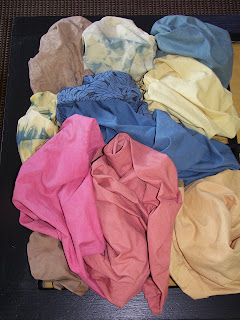A couple of weekends ago I invited some friends over and we had "Fiber Fest". The weather was beautiful, warm and sunny. We all worked on our own "fiber" projects, some playing with natural dyes all weekend. On the Wednesday evening before Carla came over and we began mordanting her cotton fabric (which takes a good 3 days to complete), then Kay came Friday night and we mordanted her wool fabric and yarn. Becky and Windi came Friday, set up their camp in my backyard and threw their linen in the mordant pot. This was everyone Sat. afternoon, taking a break and sharing ideas, Judy is showing Jody a cute wool pincushion pattern.
This was everyone Sat. afternoon, taking a break and sharing ideas, Judy is showing Jody a cute wool pincushion pattern.

One of the first dye pots was onion skins, one of our favorites, this is Carla's cotton in first before the wool goes in and sucks up all the dye. We would give her fabric a "head start".

Kay checking out some of the first dyed fabrics. She's loving her wool!

Some of the wool fabrics (some with onion skins still clinging) and a couple of skeins of Kays yarn, 70% wool and 30% cotton. It is so beautiful in real life, the way the dye reacted to the different fibers.

Windi and Beckys camp, they do Renaissance reenacting and this is a traditional "tent" called a lean pee.
 Becky with her raw sheep wool, she spent a good deal of time washing and sorting it.
Becky with her raw sheep wool, she spent a good deal of time washing and sorting it. Becky learning how to spin with a drop spindle.
Becky learning how to spin with a drop spindle.
Her first hand spun skein of wool!
 Carla with the indigo pot. She was very careful not to get bubbles in the dye pot and ended up spending a lot of time in this position, dipping the fabrics and yarn.
Carla with the indigo pot. She was very careful not to get bubbles in the dye pot and ended up spending a lot of time in this position, dipping the fabrics and yarn. Some of our fabrics, the green was originally yellow (goldenrod) over dyed with the indigo.
Some of our fabrics, the green was originally yellow (goldenrod) over dyed with the indigo.
At night Windi and her friend TJ fired up their torches and made glass beads. They made some beautiful beads, I was so tired I didn't get a picture of them.

Some of the linen fabrics the girls dyed. The fabrics with the tie-dye look Windi wrapped around blown-out goose eggs and dipped them in different dye pots. She dyed her fabric and eggs at the same time. She's very clever.












































